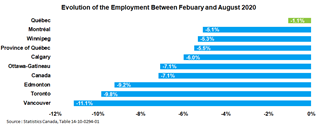Highlights
- According to Statistics Canada’s Labour Force Survey (LFS), the number of people employed increased by 17,400 (+4.2%) in the Québec City census metropolitan area (CMA) in August compared to the previous month.
- The Québec City CMA stands out compared to the rest of Canada due to its resilience, showing a 1.1% drop in the employment rate in August compared to February 2020. This is the lowest decrease among major Canadian CMAs.
- The Québec City region’s unemployment rate continued its fall, reaching 6.3% in August, the lowest among the eight major Canadian CMAs. However, the number of unemployed people rose by 10,000 compared to the beginning of the economic crisis (February 2020, +56.1%).
- The number of people active in the labour market grew by 7,300 in August, bringing the total labour force to 462,900 people.
- In the province of Quebec, comparable data shows an increase of 133,100 (+3.3%) in the number of people employed in August. As for the employment rate, it reached 9.6% in August, down from 11.3% in July.
Charts


Commentary
Results from Statistics Canada’s Labour Force Survey (LFS) show that the number of people employed in the Québec City region increased by 17,400 (+4.2%) in August, while the unemployment rate continued to fall, reaching 6.3%. This data indicates that the economic recovery is continuing.
Compared to the beginning of the crisis, the Québec City CMA’s labour market stands out among the other major Canadian CMAs due to its resilience, as the region registered the lowest decline in employment when compared to the level observed in February 2020. According to the LFS, the number of people employed was 433,600 in August, compared to 438,300 in February. This represents a loss of 4,700 jobs (‑1.1%). Although surprising, this positive result is consistent with the fast recovery in employment observed in the province (-5.5%).
The number of unemployed people dropped in August, with 10,200 fewer people than in the previous month. Overall, there were 29,200 unemployed people in August, compared to 18,700 in February 2020 (+26.1%), almost 1.5 times the level observed before the crisis. As for the Québec City region’s unemployment rate, it dropped to 6.3% in August, the lowest in Canada. Note that this rate registered a second monthly drop in a row, narrowing the gap with the unemployment rate pre-coronavirus. Let us recall that previously, the region’s unemployment rate had been continuously under the 5% threshold since February 2020.
The number of people active in the labour market grew by 7,300 people in August. This increase, supported by the economic recovery, brings the labour market to a total of 462,900 active workers, 5,900 more than in February. The region’s participation and employment rates both increased in August, reaching 67% and 62.7%.
Based on data from Statistics Canada, the increase in the Québec City region's employment in August is explained primarily by the services sector. The goods-producing sector also seems to have grown. Note that we will publish, in the following weeks, a more complete picture of the sectoral variations in employment over the past months.
Note to readers
The available data for the Québec City census metropolitan area (CMA) was given special treatment (three-month moving average) due to the small sample size, which mitigated the strong fluctuations in the data. The situation from the past months causes extreme variations which cannot be fully observed with this data. Furthermore, this data provides insight into the trend over the past three months. Thus, the data collected in June and July influenced the estimations published for the month of August. Please note that we use comparable data for the province of Quebec and the other CMAs in this document.
The Labour Force Survey’s (LFS) data for July was collected from respondents during the reference week of August 9 to 15. Let us recall that the data for June was collected from June 14 to 20, as the reopening of the economy was already well underway. On June 25, public health authorities further lessened the restrictions which, from that day on, were limited to large events and regular vacation camps with accommodation. As a result, the lifting of restrictions on the economy is strongly reflected in the results observed in August.
Statistics Canada’s definition of “unemployment” is based on the activity of job search and the availability to take a job. Therefore, the definition of unemployed people is those who, during the reference week of August 9 to 15, were available to work and:
- were without work, but had looked for work in the past four weeks,
- were on temporary layoff with an expectation of recall, or
- were without work, but had a job to start within four weeks from the reference week.
To learn more, please visit: https://www150.statcan.gc.ca/n1/en/catalogue/71-543-G
Émile Émond
Economist
Québec International



